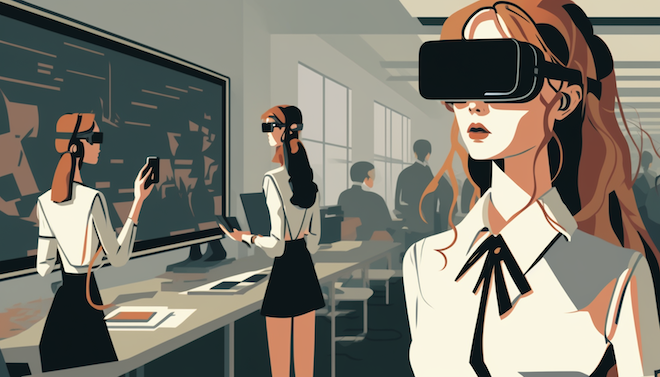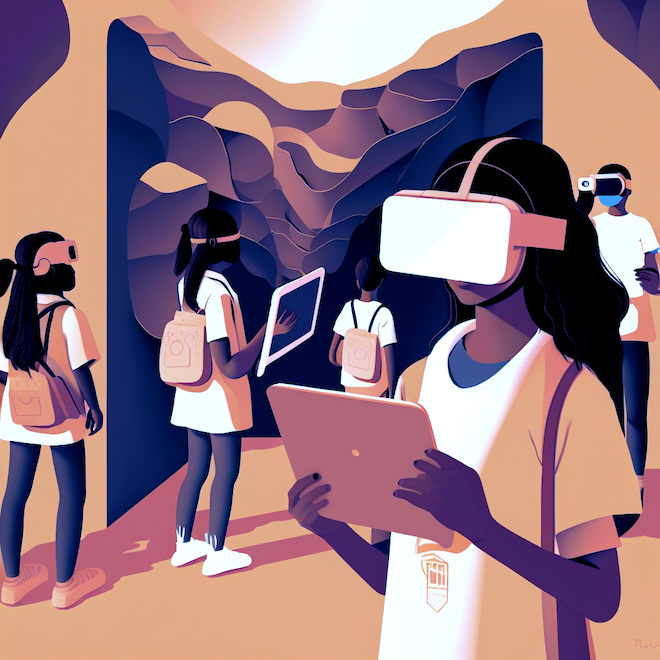
This article is published in collaboration with The MeshMinds Foundation.
Are you ready to step into the future of education? Picture a classroom where students can step into a virtual world, explore immersive environments, and collaborate with peers in a way that was once only imaginable in science fiction. This scenario is closer to reality than one might expect. In fact, in Singapore, a student from the Nanyang Girls High School Art Programme has already taken the initiative to explore the possibilities of the metaverse by building a 3D virtual art exhibition on Roblox, an online platform offering 3D immersive digital experiences. Two others are using online platforms Meta Spark and Artivive to make their artworks come to life. These projects not only highlight the potential of the metaverse in the classroom but also underscore the creativity and ingenuity of today's students.
The use of digital technologies, including the metaverse, has become increasingly popular in classrooms in the past 3 years due to the COVID-19 pandemic and the need to improve access to education.
Getting quality education is at the heart of the Sustainable Development Goals (SDG). SDG 4 seeks to ensure that everyone has access to inclusive and equitable quality education, as well as promote lifelong learning opportunities for all. This is where the metaverse comes in. It can provide students a unique opportunity to explore and learn through new extended reality (XR) technologies and 3D experiences. At the same time, it offers the opportunity to expand on traditional models of instruction and memorization by fusing social and environmental studies with digitized learning. Using the metaverse in the classroom can encourage active participation, social connection, and critical thinking.
How governments are making way for the metaverse
However, there are challenges in adopting technology, more specifically the metaverse, in the classroom more widely. Given the pace of change of technology, it is difficult to expect educators to immediately become experts in frontier technologies. A better way to ease them into this brave new world of metaverse pedagogy is by introducing hybrid learning environments in the classroom, powered by the latest technologies. Whether as providers of these digital experiences or trainers for the educators, XR creators are essential to develop an effective, inspiring metaverse pedagogy.

Outside of the classroom, educators should also be trained in digital literacy and shown how to incorporate digital approaches into their lesson plans. The Digital Rise Program, launched by the Philippine Department of Education (DepEd) tackles the difficulties associated with digital learning and educational technology. The challenge of integrating technology in education became more obvious during the COVID-19 pandemic. “We have come a long way, and we have learned a lot from the pandemic, but the greatest takeaway from this past year is that we have to be willing, flexible, and embrace technology,” said former Philippine Education Secretary Leonor Magtolis Briones.
To address the issue, in addition to teaching students digital literacy, including the use of essential documentation software, programming skills, and advanced multimedia communication tools, DepEd is prioritizing the improvement of digital skills among educators. Through a technology-assisted teaching program, teachers are provided with equipment, digitized materials for lesson plans, software, and courses to help them integrate digital technology into their daily classroom instruction and learning resources.
Similarly, Indonesia developed the National Medium-Term Development Plan that pays close attention to education and proficiency in digital technology. The Ministry of Communication and Information Technology has organized digital technology adoption programs in several areas, including in Bali, Batam, and Klaten, among others.
In Singapore, the government launched the National Digital Literacy Programme, which equips students with skills to thrive in a digital society and take on jobs of the future. In addition, the National Arts Council Singapore published its SG Arts Plan 2.0, which commits to creating an immersive city of creativity filled with art—in real life, in augmented reality, and in the metaverse.
The metaverse is already here
Yes, the metaverse is here and already being applied in a number of ways to help both educators and students.
With technology changing so fast, we cannot expect educators to be able to stay ahead of the curve all the time. One way to help them is to enable partnerships between schools and XR creators. For instance, the School of Technology for the Arts at Republic Polytechnic in Singapore supports the integration of good quality, self-directed learning resources, like the Meta Immersive Learning Academy, which offers local language videos for Indonesia, Japan, Republic of Korea, Singapore, and Taipei,China.
Embracing digitization in education offers teachers various methods and techniques to conduct their lessons and engage students according to their needs. Studies have shown that VR, in particular, offers higher levels of engagement compared with more traditional methods which rely on textbooks and videos.
Adopting home-based learning using metaverse technologies such as AR and VR could also provide students the opportunity to advance their education at home. This is particularly helpful to children who may not always thrive in a traditional classroom setting.

In Japan, complex home environments and the pandemic have led to an increase in school absenteeism, with a record 244,940 students missing school in March 2022. To support students, the Tokyo-based nonprofit organization Katariba uses the metaverse to offer educational support through an online learning space called Room-K. The platform assists children to establish relationships with counselors, develop a sense of belonging, and enhance their social skills. The aim is to encourage the children to better focus on their studies.
Metaverse technology can also help students with disability. Children with autism, social interaction issues, and those with special needs can attain social and life-skills through virtual simulations, such as when crossing the road or visiting unfamiliar places. Though digital learning for students with disability is yet to be fully developed, online resources such as special education and speech therapy app Otsimo can help enhance student learning and personal development.
The metaverse can also democratize education regardless of student's socioeconomic background. The beauty of home-based metaverse learning is its accessibility to students, wherever they may be. The Meraki Academy, a Singapore-based edutech startup, offers collaborative and curated curriculums that are suited to the needs and learning styles of digitally driven youth. With their goal of democratizing education, the academy offers classes, which can be accessed via desktops, tablets, mobile phones, and VR headsets for relatively affordable fees from $30 per month.
These examples illustrate just how powerful the metaverse can be as a tool for educators and students. The metaverse offers a unique opportunity to reimagine traditional learning systems by integrating extended reality technologies and 3D experiences. It also promotes active participation, social connection, and critical thinking at the core.
The potential of the metaverse to democratize education by breaking down barriers and opening new opportunities for individuals to access knowledge and enhance their skills is immense. We should take steps now to leverage the metaverse to make education more equitable and inclusive.
 Justinne Alethea Casuga
Justinne Alethea Casuga
Chief Storyteller, MeshMinds
As chief storyteller at MeshMinds, Justinne Alethea Casuga believes in the power of narratives to drive empathy, inspire action and foster a positive impact for people and the planet. Her interests in art, design, and technology has led her to explore the exciting realm of digital storytelling to engage audiences in new and meaningful ways.
 Kay Poh Gek Vasey
Kay Poh Gek Vasey
Founder, MeshMinds Foundation; Chief Connecting Officer, MeshMinds
Kay Poh Gek Vasey is the chief connecting officer at MeshMinds, which operates as a creative technology studio. Kay offers expertise and advocacy on XR creation and production; metaverse pedagogy; digital sustainability; digital transformation; and the future of art and creativity. She believes in the power of artists to inform conversations and inspire positive actions that result in measurable impact for a better world.


